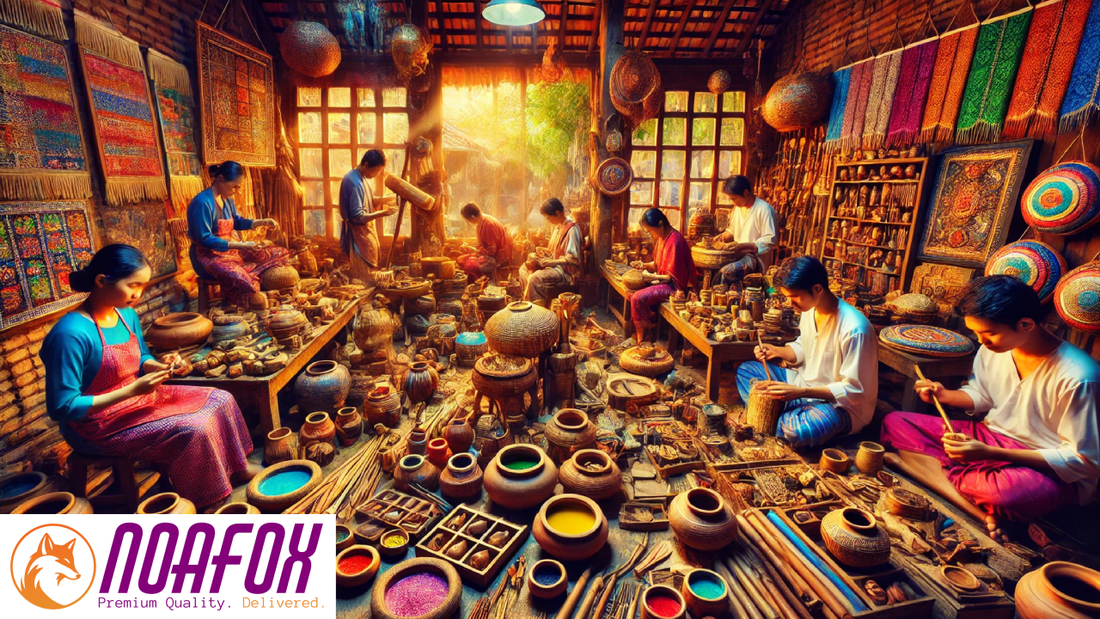
Market Size, Opportunities and Challenges of Handicraft Business | Noafox
What is a Handicraft Business?
Handicraft businesses are entrepreneurial ventures that focus on producing and selling goods made primarily by hand, using traditional techniques and skills. These goods often showcase the cultural heritage, craftsmanship, and artistic flair of the artisans, making each item unique. Handicrafts can include pottery, weaving, wood carving, jewelry making, textiles, metalwork, and various decorative and functional objects. The key value of these items lies in the skill, creativity, and cultural significance embedded in each piece.
The rise of handicraft businesses globally reflects a shift toward sustainable and ethical consumerism, as handmade goods are often environmentally friendly, produced with fewer industrial resources, and support local artisans and economies. The handicraft industry is diverse, encompassing both large-scale operations and smaller, home-based businesses or cooperatives, and its market spans everything from local markets and festivals to global e-commerce platforms like Etsy, Amazon Handmade, and regional online shops.
Market Size of the Handicraft Industry: India and Globally
Global Market Size
The global handicrafts market has been on a steady growth trajectory, driven by increased appreciation for handmade goods and a growing demand for sustainable, culturally rich products. In 2023, the global handicrafts market was estimated to be worth over $700 billion, and it is projected to reach nearly $1 trillion by 2028, with a compound annual growth rate (CAGR) of 8–10%. Key regions in this market include Asia-Pacific, North America, and Europe, with a growing customer base in both developed and emerging economies.
This growth is fueled by several factors, including:
- E-commerce expansion: Platforms like Etsy, eBay, and Amazon have brought handicrafts to a global audience.
- Consumer trends: Increasing demand for sustainable and unique products.
- Tourism: Handicrafts are often sold as souvenirs, representing cultural experiences for tourists.
Market Size in India
India holds a prominent position in the global handicrafts industry, largely due to its rich cultural diversity and skilled artisan workforce. The Indian handicrafts sector contributes around $7 billion to the country's economy and has the potential to grow significantly with increased global demand. Additionally, India's government initiatives, such as the “Make in India” and “Skill India” campaigns, along with handicraft fairs and expos, have boosted the visibility and accessibility of Indian handicrafts in international markets.
Indian handicrafts are exported to numerous countries, with major buyers in the United States, United Kingdom, Germany, France, and other European nations. Major handicraft hubs in India include:
- Rajasthan: Known for textiles, pottery, and jewelry.
- Uttar Pradesh: Famous for its brassware and marble crafts.
- Kashmir: Celebrated for carpets, shawls, and paper mache crafts.
- West Bengal: Known for jute and terracotta art.
These handicraft hubs drive India’s export earnings and provide employment to millions of artisans and craftsmen across the country.
Opportunities in the Handicraft Business
-
E-commerce Platforms and Marketplaces
- The advent of digital marketplaces has given artisans access to global customers, helping them bypass traditional intermediaries and reach their target audience directly. E-commerce platforms allow handicraft businesses to showcase their products to a broader audience with minimal upfront costs.
-
Tourism and Souvenir Market
- Tourists often look for unique, culturally significant souvenirs. Handicraft businesses can thrive in areas with high tourist traffic by offering locally inspired and crafted products. There’s also potential for businesses to partner with hotels, resorts, and tourism agencies to promote authentic crafts to travelers.
-
Sustainable and Ethical Consumerism
- As more consumers prioritize sustainability, eco-friendly handicrafts are seeing increased demand. Many handicraft businesses use recycled, natural, or locally sourced materials, aligning well with the values of environmentally conscious shoppers.
-
Corporate Gifting and Customization
- Handicrafts provide an opportunity for businesses to offer unique and personalized corporate gifts. Customization and personalization of products, such as handcrafted stationery, mugs, and textile products, are popular among companies looking to provide employees or clients with something unique.
-
Interior Design and Home Decor
- The demand for artisanal decor items, like handmade rugs, pottery, and furniture, has surged in recent years as consumers seek to add character and authenticity to their spaces. This market is especially lucrative for artisans producing high-quality, aesthetically appealing goods.
-
Training and Workshops
- Many consumers are interested in learning handicraft skills themselves, providing opportunities for businesses to offer workshops or training sessions. Artisans can capitalize on this trend by organizing classes or creating online courses that teach traditional craft techniques, providing an additional revenue stream.
-
Collaborations with Fashion and Lifestyle Brands
- Many fashion brands and lifestyle companies are seeking to incorporate handicraft elements into their collections. Handicraft businesses can collaborate with these brands to create unique product lines that blend traditional craftsmanship with contemporary design.
Challenges in the Handicraft Business
Despite the opportunities, handicraft businesses face several challenges:
- Supply Chain Issues: Ensuring a steady supply of raw materials while maintaining quality standards can be challenging, especially for natural or traditional materials.
- Skill Development: Many artisans lack formal training in marketing, branding, and business management, which can limit their growth potential.
- Competition from Mass-Produced Goods: Handmade products often come at a premium, which can make it hard to compete with cheaper, mass-produced alternatives.
Conclusion
The handicraft business offers significant opportunities for both local and global markets. As the demand for handmade, eco-friendly, and culturally rich products grows, the sector has a strong potential to thrive, especially with support from e-commerce and government initiatives. Although challenges remain, the trend toward sustainable, ethically produced goods and personalized experiences continues to position the handicraft business as an appealing venture for artisans, entrepreneurs, and investors alike.
